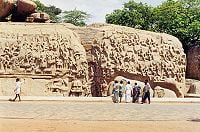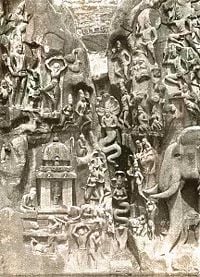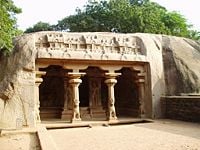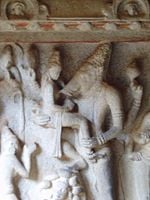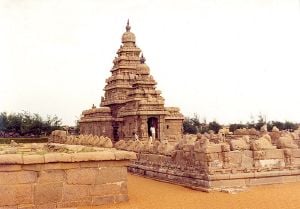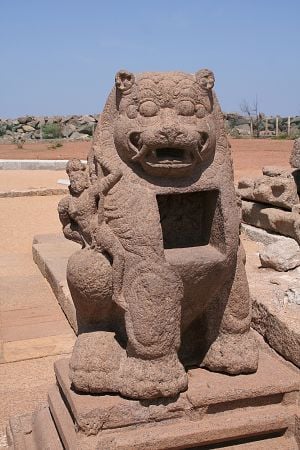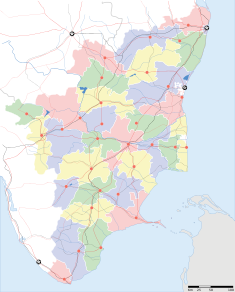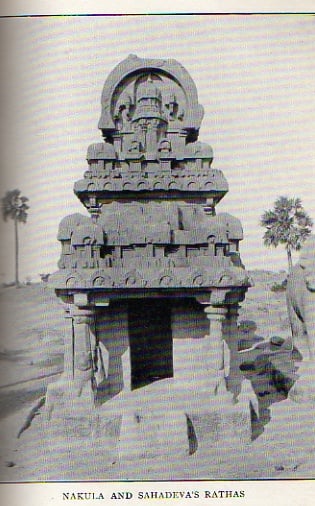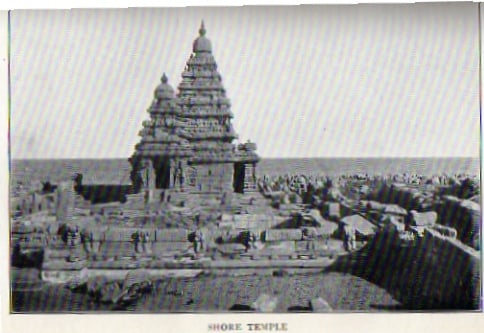Difference between revisions of "Mahabalipuram" - New World Encyclopedia
Dan Davies (talk | contribs) |
Dan Davies (talk | contribs) |
||
| Line 285: | Line 285: | ||
}} | }} | ||
| − | According to descriptions by early travel writers from [[Great Britain|Britain]], the area near Mahabalipuram had seven [[pagoda]]s by the sea. | + | According to descriptions by early travel writers from [[Great Britain|Britain]], the area near Mahabalipuram had seven [[pagoda]]s by the sea. British traveler [[John Goldingham]], who provided the first written accounts of Mahabalipuram, told of the "[[Seven Pagodas of Mahabalipuram|Seven Pagodas]]" when he visited in 1798. |
| − | An ancient port city and parts of a temple built in the 7<sup>th</sup> century may have been uncovered by the [[tsunami]] that resulted from the [[2004 Indian Ocean earthquake]]. As the waves gradually receded, the force of the water removed sand deposits that had covered various rocky structures and revealed carvings of animals, which included an elaborately carved head of an elephant and a horse in flight. A small square-shaped niche with a carved statue of a deity could be seen above the head of the elephant. In another structure, | + | An ancient port city and parts of a temple built in the 7<sup>th</sup> century may have been uncovered by the [[tsunami]] that resulted from the [[2004 Indian Ocean earthquake]]. As the waves gradually receded, the force of the water removed sand deposits that had covered various rocky structures and revealed carvings of animals, which included an elaborately carved head of an elephant and a horse in flight. A small square-shaped niche with a carved statue of a deity could be seen above the head of the elephant. In another structure, a sculpture of a reclining lion appeared, consistent with the use of animal sculptures as decorations on walls and temples from the Pallava period in the 7<sup>th</sup> and [[8th century|8<sup>th</sup>]] centuries. |
The [[Archaeological Survey of India]] sent divers to begin underwater excavations of the area on February 17, 2005. | The [[Archaeological Survey of India]] sent divers to begin underwater excavations of the area on February 17, 2005. | ||
| Line 295: | Line 295: | ||
==== The Myths ==== | ==== The Myths ==== | ||
| − | [[Image:Mahabali005.jpg|frame|right|Nakula and Sahadeva's Rathas, part of the Seven Pagodas complex, circa 1914. Courtesy J.W. Coombes.]] | + | [[Image:Mahabali005.jpg|frame|right|Nakula and Sahadeva's Rathas, part of the Seven Pagodas complex, circa 1914. Courtesy J.W. Coombes.]] |
| − | An ancient [[Brahman]] legend explains the pagodas’ origins in mythical terms. | + | The name “Seven Pagodas” has served as a nickname for the south Indian city of [[Mahabalipuram]], also called Mamallapuram, since the first European explorers reached the city. The phrase “Seven Pagodas” refers to a myth that has circulated in India, Europe, and other parts of the world for over eleven centuries. Mahabalipuram’s '''Shore Temple''', built in the eighth century C.E., stands at the shore of the [[Bay of Bengal]]. Legend has it that six other temples once stood with it. |
| + | |||
| + | An ancient [[Brahman]] legend explains the pagodas’ origins in mythical terms. Prince [[Hiranyakasipu]] refused to worship the god [[Vishnu]]. The prince’s son, [[Prahlada]], loved Vishnu greatly, and criticized his father’s lack of faith. Hiranyakasipu banished Prahlada, but then relented and allowed him to come home. Father and son quickly began to argue about Vishu’s nature. When Prahlada stated that Vishnu had presence everywhere, including in the walls of their home, his father kicked a pillar. Vishnu emerged from the pillar in the form of a man with a lion’s head, and killed Hiranyakasipu. Prahlada eventually became king, and had a son named Bali. Bali founded Mahabalipuram on that site. (Adapted from Coombes, 23-4.) | ||
==== Unclear ancient evidence ==== | ==== Unclear ancient evidence ==== | ||
| − | The temples’ origins have been obscured by time, lack of complete written records, and storytelling. | + | The temples’ origins have been obscured by time, lack of complete written records, and storytelling. Englishman D. R. Fyson, a long-time resident of Madras (now [[Chennai]]), wrote a concise book on the city of Mahabalipuram titled ''Mahabalipuram or Seven Pagodas'', which he intended as a souvenir volume for Western visitors to the city. In it, he states that the [[Pallava]] King Narasimharavarman I either began or greatly enlarged upon Mahabalipuram, circa 630 C.E. (Fyson 1). Archaeological evidence has yet to clearly proven whether Narasimharavarman I’s city had been the earliest to inhabit the location. |
| − | About | + | About thirty years prior to the founding of Narasimharavarman I’s city, Pallava King Mahendravarman I had begun a series of “cave temples” carved into rocky hillsides (Fyson 2). Contrary to what the name suggests, they often began as man-made caves. Mahendravarman I and Narasimharavarman I also ordered construction of free-standing temples, called rathas in the region’s language, [[Tamil language|Tamil]]. Nine rathas currently stand at the site (Ramaswami, 209). Construction of both types of temples in Mahabalipuram appears to have ended around 640 C.E. (Fyson 3). Fyson states that archaeological evidence supports the claim that a monastery, or vihara in Tamil, existed in ancient Mahabalipuram. The idea of the monastery would have been adopted from practices of the region’s past Buddhist inhabitants. Fyson suggests that the monks’ quarters may have been divided between a number of the city’s rathas, based on their division into small rooms. Buddhist influence appears in the traditional pagoda shape of the Shore Temple and other remaining architecture (Fyson 5). |
| − | Fyson devoted only the next to the last page of his slim book to the actual myth of the Seven Pagodas (Fyson 28). | + | Fyson devoted only the next to the last page of his slim book to the actual myth of the Seven Pagodas (Fyson 28). He recounts a local myth regarding the pagodas, that the god Indra became jealous of that earthly city, and sank it during a great storm, leaving only the Shore Temple above water. He also recounts the assertion of local Tamil people that at least some of the other temples can be seen “glittering beneath the waves” from fishing boats (Fyson 28). Whether the six missing pagodas exist seems unimportant to Fyson; the Seven Pagodas gave his beloved city its nickname and fame, and that seems the important part for him. The six missing temples have continued to fascinate locals, archaeologists, and lovers of myth alike, and have recently returned to the archaeological spotlight. |
==== European explorers ==== | ==== European explorers ==== | ||
| − | N. S. Ramaswami names [[Marco Polo]] as one of the earliest European visitors to Mahabalipuram. | + | N. S. Ramaswami names [[Marco Polo]] as one of the earliest European visitors to Mahabalipuram. Polo left few details of his visit, marking it on his Catalan Map of 1275 (Ramaswami, 210). Many Europeans later spoke of the Seven Pagodas following travelers to their colonies in India. As mentioned above, [[John Goldingham]], an English astronomer living in Madras in the late 18th and early 19th centuries, wrote about them first. He wrote an account of his visit and the legend in 1798, later collected by Mark William Carr in his 1869 book ''Descriptive and Historical Papers Relating to the Seven Pagodas on the Coromandel Coast''. Goldingham mainly described art, statues, and inscriptions found throughout the archaeological site at Mahabalipuram. He copied many of the inscriptions by hand, and included them in his essay. Goldingham interprets most of the signs as picture-symbols, and discusses what meaning their shapes may have (Goldingham, 30-43). Interestingly, Benjamin Guy Babington, author of another essay in the same volume, identified several of the figures in Goldingham’s copied inscriptions as [[Telugu language|Telugu]] letters (Goldingham, 43). A footnote to Goldingham’s work includes Babington’s note on the text. |
| − | |||
| − | Many Europeans later spoke of the Seven Pagodas following travelers to their colonies in India. | ||
| − | In 1914, British writer J.W. Coombes related the common European belief on the origin of the pagoda legend. | + | In 1914, British writer J.W. Coombes related the common European belief on the origin of the pagoda legend. According to him, the pagodas once stood on the edge of the shore, and their copper domes reflected sunlight and served as a nautical landmark. He claims that modern people lack knowledge of how many pagodas once existed. He believes that the number close to seven (Coombes, 27). |
| − | Indian historian N. S. Ramaswami places much of the responsibility for the myth’s European propagation on the poet [[Robert Southey]], who mentioned it in his poem “The Curse of Kehama,” published in 1810 (Ramaswami, 205). | + | Indian historian N. S. Ramaswami places much of the responsibility for the myth’s European propagation on the poet [[Robert Southey]], who mentioned it in his poem “The Curse of Kehama,” published in 1810 (Ramaswami, 205). He refers to the city by another of its popular names, Bali. In his poem, Southey clearly states that more than one of the Seven Pagodas could be seen. (See stanza 4). Southey told romantic tales of many cultures around the world, including [[India]], [[Rome]], [[Portugal]], [[Paraguay]], and [[Native Americans in the United States|Native American]] tribes, all of which had been based on accounts of others’ travels, and his own imagination. “The Curse of Kehama” certainly played a role in rising Orientalism. |
| − | Ramaswami’s | + | Ramaswami’s had mixed comments on European explorers' reports. He notes that, before Europeans began to visit [[South India]] toward the beginning of the [[Raj]], many of the smaller monuments at Mahabalipuram had been partially or entirely covered with sand. The colonizers and their families played an important role in uncovering the archaeological site in their free time. Once early English archaeologists realized the extent and beauty of the site, toward the end of the eighteenth century, they appointed experienced antiquarians such as [[Colin Mackenzie]] to preside over the dig (Ramaswami, 210). |
==== Missing evidence ==== | ==== Missing evidence ==== | ||
| − | [[Image:Mahabali006.jpg|frame|left|Shore Temple, circa 1914. Courtesy J.W. Coombes.]]Before the [[tsunami]] that occurred on [[December 26, 2004]], evidence for the existence of the Seven Pagodas | + | [[Image:Mahabali006.jpg|frame|left|Shore Temple, circa 1914. Courtesy J.W. Coombes.]]Before the [[tsunami]] that occurred on [[December 26, 2004]], evidence for the existence of the Seven Pagodas had been largely anecdotal. The existence of the Shore Temple, smaller temples, and rathas supported the idea that the area had strong religious significance, but little contemporary evidence, save one Pallava-era painting of the temple complex, existed. Ramaswami wrote in his 1993 book ''Temples of South India'' that evidence of 2000 years of civilization, 40 currently visible monuments, including two “open air [[bas-relief]]s,” and related legends spreading through both South Asia and Europe had caused people to build up Mahabalipuram’s mystery in their minds (Ramaswami, 204). He writes explicitly that: “There is no sunk city in the waves off Mamallapuram. The European name, ‘The Seven Pagodas,’ is irrational and cannot be accounted for” (Ramaswami, 206). |
| − | Anecdotal evidence can be truthful though, and in 2002 scientists decided to explore the area off the shore of Mahabalipuram, where many modern Tamil fishermen claimed to have glimpsed ruins at the bottom of the sea. | + | Anecdotal evidence can be truthful though, and in 2002 scientists decided to explore the area off the shore of Mahabalipuram, where many modern Tamil fishermen claimed to have glimpsed ruins at the bottom of the sea. That project had been a joint effort between the National Institute of Oceanography (India) and the Scientific Exploration Society, U.K (Vora). The two teams found the remains of walls beneath five to eight meters of water and sediment, 500 to 700 meters off the coast. The layout suggested that they belonged to several temples. Archaeologists dated them to the Pallava era, roughly when Mahendravarman I and Narasimharavarman I ruled the region (Vora). NIO scientist K.H. Vora noted after the 2002 exploration that the underwater site probably contained additional structures and artifacts, and merited future exploration (Vora). |
==== During the tsunami ==== | ==== During the tsunami ==== | ||
Revision as of 17:59, 2 December 2007
| Group of Monuments at Mahabalipuram* | |
|---|---|
| UNESCO World Heritage Site | |
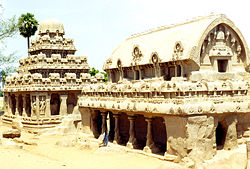
| |
| Type | Cultural |
| Criteria | i, ii, iii, iv |
| Reference | 249 |
| Region** | Asia-Pacific |
| Inscription history | |
| Inscription | 1984 (8th Session) |
| * Name as inscribed on World Heritage List. ** Region as classified by UNESCO. | |
Mahabalipuram (Tamil:மகாபலிபுரம்) (also known as Mamallapuram) refers to a town in Kancheepuram district in the Indian state of Tamil Nadu. It has an average elevation of 12 metres (39 feet).
Mahabalipuram had been a 7th century port city of the South Indian dynasty of the Pallavas around 60 km south from the city of Chennai in Tamil Nadu. Historians speculate that the town had been named after the Pallava king Mamalla. It had numerous historic monuments built between the 7th and the 9th century. UNESCO designated Group of Monuments at Mahabalipuram a World Heritage Site.
Landmarks
The monuments, mostly rock-cut and monolithic, constitute the early stages of Dravidian architecture wherein Buddhist elements of design display prominently. Cave temples, monolithic rathas (chariots), sculpted reliefs and structural temples constitute the majority of the monuments. The pillars have been sculpted in the Dravidian tradition; the sculptures provide excellent examples of Pallava art.
Some historians believe that the area served as a school for young sculptors. The different sculptures, some half finished, may have been examples of different styles of architecture, probably demonstrated by instructors and practiced on by young students. That can be seen in the Pancha Rathas where each Ratha has been sculpted in a different style.
Some important structures include:
Thirukadalmallai
The temple Thirukadalmallai had been dedicated to Lord Vishnu. Pallava King built the temple to safeguard the sculptures from corrosion and destruction by the ocean. Records state that, after building the temple, the remaining temple grounds remained preserved from harm by the sea.
| Sri Sthalasayana Perumal | |
Sthalasayana Perumal | |
| Temple Name: | ThiruKadalMallai |
|---|---|
| Alias Name: | Sthalasayana Perumal Kovil |
| God Name: | Sri Sthalasayana Perumal |
| Goddess Name: | Nilamangai Thayaar |
| Pushkarni: | Pundarika Pushkarni |
| Vimanam: | GaganaKriti Vimanam |
| Location: | Mahabalipuram |
| State and Country: | TamilNadu, India |
The Sthalasayana Perumal Temple is at Mahabalipuram. The Temple resides as the first and foremost of Mahabalipuram sculputres. It is one of the 108 Divya desam.
The temple
The temple stands on the shore, built in the same period as the sculptures at the site. A small temple, the edifice stands with two major shrines, one for Lord Sthalasayana Perumal and another Nilamangai Thayaar. The site has been noted as the avatrasthalam (birthplace) of Bhoothathazhwar, the 2nd Azhwar. A separate shrine stands for Lord Narasimha, built by Pallava kings, displays pallava style architecture.
Legend
Legend relates that Sage Pundareeka worshipped Lord Vishnu, offering him with lotus flowers asking for a divine vision of Lord Vishnu. Seeing his devotion, Lord Vishnu came in guise as an old man begging for food. The sage went to get food for the old man. When he returned, he found Lord Vishnu in a Ananthasayana posture wearing the lotus flowers offered by the sage. He then realized that the Lord himself had come in disguise of an old man to bless the devotee. In another important legend, Lord Sri Sthalasayana Perumal Mahatyam had come personally to fulfill his devotees' wishes.
In an important devotional act, the Lord receives offerings of Puliyodharai (Tamarind Rice), Dhadhyonam (Curd Rice), Pongal, Chakkarai Pongal, Vada, Adhirasam, Murukku from devotees. Maasi Makham represents an important festival. Thirumangai Alvar, Bhoothathalvar have composed beautiful Paasurams on Lord Sthalasayana Perumal and his consort Nilamangai Thayaar, one of the compositions in Naalayira Divya Prabandha.
Descent of the Ganges
Descent of the Ganges at Mahabalipuram, in the Tamil Nadu state India, has been designated by UNESCO as a World Heritage Site among the group of Mahabalipuram monuments in 1984.[1] Descent of the Ganges constitutes a giant open-air bas relief, carved of the a monolithic rock. the Pallava kings commissioned the relief in the 7th and 8th c. C.E. The legend depicted in the relief portrays the story of the descent of the sacred river Ganga to earth from the heavens led by Bhagirata. Many Hindus believe the waters of Ganges possess supernatural powers. The descent of the Ganges and Arjuna's Penance stand portrayed next to each other in stone at the Pallava heritage site.[2]
Varaha Cave Temple
Varaha Cave Temple, an example of Indian rock-cut architecture dating from the late 7th century, refers to a small rock-cut cave temple with a mandapam dating from the 7th century. Inside the side walls have large sculptured panels depicting Vishnu as Varaha, the boar, holding up Bhudevi, the earth goddess, good examples of naturalistic Pallava art. The Pallava doorkeepers are four pillars that have lion carved into the bases. Inside, on rear wall, is the shrine with guardian figures on either side.[3]
Located at Mamallapuram, a tiny village south of Chennai in the state of Tamil Nadu, India, the village served as a busy port during the 7th and 8th century reign of the Pallava dynasty. The site, famous for the rock-cut caves and the sculptured rock that line a granite hill, includes one depicting Arjuna's Penance.
[3] It has been classified as a UNESCO World Heritage Site.[4]
Arjuna's Penance
Arjuna's Penance refers to a massive open air bas-relief monolith dating from the 7th century CE located in the town of Mahabalipuram in Southern India extolling an episode from the Hindu epic, The Mahabharata. Measuring 96 feet long by 43 feet high, the bas-relief also goes by the name The Descent of Ganga since a dispute continues over which of the stories the mural depicts.
Two Interpretations
In one interpretation, some consider a figure in the bas-relief standing on one leg Arjuna performing an austerity Tapas to receive a boon from Shiva as an aid in fighting the Mahabharata war. Arjuna received Pasupata, Shiva's most powerful weapon, as the boon.
The bas relief situates on a rock with a cleft. Above the cleft stood a collecting pool; at one time, water may have flowed along the cleft. Some believe that figures within the cleft represent Ganga or the River Ganges and Shiva, providing the basis for an alternative interpretation of the mural. They forward that rather than Arjuna, the figure performing austerities represents Bhagiratha. Bhagiratha performed austerities so that Ganga might descend to earth and wash over the ashes of his relatives, releasing them from their sins. To break Ganga's fall from heaven to earth, she falls onto Shiva's hair, which divides into many streams by his tresses.
Figures
A cat standing on one leg (apparently as an austerity) represents one of the notable, and perhaps ironic, figures in the bas-relief. That may relate to the Panchatantra story of the cat who poses as an ascetic to lure a hare and a bird to come near. When near, he devours them.
Shore Temple
The Shore Temple - a structural temple built with blocks of granite, dating from the 8th century C.E. Built on a promontory protruding into the Bay of Bengal at Mamallapuram along the Bay of Bengal, the temples has its entrance from the western side away from the sea. Recent excavations have revealed new structures here. The temple had been reconstructed stone by stone from the sea after being washed away in a cyclone. It has been classified as a UNESCO World Heritage Site.[5]
Architecture
The Shore Temple, a five-storeyed rock cut structural Hindu temple rather than monolithical in the style of other monuments at the site. The earliest important structural temple in Southern India, the pyramidal structure stands 60 ft high and sits on a 50 ft square platform. A small temple, the original porch, sits in front. It is made out of finely cut local granite.[6][7] [8]
The temple has a garbhagriha, which enshrines the deity, Sivalinga, and a small mandapa surrounded by a heavy outer wall with space between for circumambulation. At the rear two shrines stand facing opposite directions. The inner shrine, dedicated to Ksatriyasimnesvara, may be reached through a passage while the other, dedicated to Vishnu, faces the outside. The outer wall of the shrine to Vishnu and the inner side of the boundary wall have extensive sculpting and topped by large sculptures of Nandi.[6]Plaster divides the temple's outer walls into bays, the lower part being carved into a series of rearing lions.[9] Recent excavations have revealed new structures here under the sand.[10][7]
The Durga seats on her lion vahana. A small shrine may have been in the cavity in the lion's chest.[7]
Pancha Rathas
Pancha Rathas (Five Chariots) - five monolithic pyramidal structures named after the Pandavas (Arjuna, Bhima, Yudhishtra, Nakula and Sahadeva) and Draupadi. Interestingly the rathas, despite their sizes, had not been assembled—each had been carved from one single large piece of stone.
Underwater city
| Mahabalipuram Tamil Nadu • India | |
| Coordinates: | |
| Time zone | IST (UTC+5:30) |
| Area • Elevation |
• 12 m (39 ft) |
| District(s) | Kancheepuram |
| Population | 12,049 (2001) |
| Codes • Pincode • Telephone • Vehicle |
• 603104 • +91-44 • TN-21 |
Coordinates:
According to descriptions by early travel writers from Britain, the area near Mahabalipuram had seven pagodas by the sea. British traveler John Goldingham, who provided the first written accounts of Mahabalipuram, told of the "Seven Pagodas" when he visited in 1798.
An ancient port city and parts of a temple built in the 7th century may have been uncovered by the tsunami that resulted from the 2004 Indian Ocean earthquake. As the waves gradually receded, the force of the water removed sand deposits that had covered various rocky structures and revealed carvings of animals, which included an elaborately carved head of an elephant and a horse in flight. A small square-shaped niche with a carved statue of a deity could be seen above the head of the elephant. In another structure, a sculpture of a reclining lion appeared, consistent with the use of animal sculptures as decorations on walls and temples from the Pallava period in the 7th and 8th centuries.
The Archaeological Survey of India sent divers to begin underwater excavations of the area on February 17, 2005.
Seven Pagodas of Mahabalipuram
The Myths
The name “Seven Pagodas” has served as a nickname for the south Indian city of Mahabalipuram, also called Mamallapuram, since the first European explorers reached the city. The phrase “Seven Pagodas” refers to a myth that has circulated in India, Europe, and other parts of the world for over eleven centuries. Mahabalipuram’s Shore Temple, built in the eighth century C.E., stands at the shore of the Bay of Bengal. Legend has it that six other temples once stood with it.
An ancient Brahman legend explains the pagodas’ origins in mythical terms. Prince Hiranyakasipu refused to worship the god Vishnu. The prince’s son, Prahlada, loved Vishnu greatly, and criticized his father’s lack of faith. Hiranyakasipu banished Prahlada, but then relented and allowed him to come home. Father and son quickly began to argue about Vishu’s nature. When Prahlada stated that Vishnu had presence everywhere, including in the walls of their home, his father kicked a pillar. Vishnu emerged from the pillar in the form of a man with a lion’s head, and killed Hiranyakasipu. Prahlada eventually became king, and had a son named Bali. Bali founded Mahabalipuram on that site. (Adapted from Coombes, 23-4.)
Unclear ancient evidence
The temples’ origins have been obscured by time, lack of complete written records, and storytelling. Englishman D. R. Fyson, a long-time resident of Madras (now Chennai), wrote a concise book on the city of Mahabalipuram titled Mahabalipuram or Seven Pagodas, which he intended as a souvenir volume for Western visitors to the city. In it, he states that the Pallava King Narasimharavarman I either began or greatly enlarged upon Mahabalipuram, circa 630 C.E. (Fyson 1). Archaeological evidence has yet to clearly proven whether Narasimharavarman I’s city had been the earliest to inhabit the location.
About thirty years prior to the founding of Narasimharavarman I’s city, Pallava King Mahendravarman I had begun a series of “cave temples” carved into rocky hillsides (Fyson 2). Contrary to what the name suggests, they often began as man-made caves. Mahendravarman I and Narasimharavarman I also ordered construction of free-standing temples, called rathas in the region’s language, Tamil. Nine rathas currently stand at the site (Ramaswami, 209). Construction of both types of temples in Mahabalipuram appears to have ended around 640 C.E. (Fyson 3). Fyson states that archaeological evidence supports the claim that a monastery, or vihara in Tamil, existed in ancient Mahabalipuram. The idea of the monastery would have been adopted from practices of the region’s past Buddhist inhabitants. Fyson suggests that the monks’ quarters may have been divided between a number of the city’s rathas, based on their division into small rooms. Buddhist influence appears in the traditional pagoda shape of the Shore Temple and other remaining architecture (Fyson 5).
Fyson devoted only the next to the last page of his slim book to the actual myth of the Seven Pagodas (Fyson 28). He recounts a local myth regarding the pagodas, that the god Indra became jealous of that earthly city, and sank it during a great storm, leaving only the Shore Temple above water. He also recounts the assertion of local Tamil people that at least some of the other temples can be seen “glittering beneath the waves” from fishing boats (Fyson 28). Whether the six missing pagodas exist seems unimportant to Fyson; the Seven Pagodas gave his beloved city its nickname and fame, and that seems the important part for him. The six missing temples have continued to fascinate locals, archaeologists, and lovers of myth alike, and have recently returned to the archaeological spotlight.
European explorers
N. S. Ramaswami names Marco Polo as one of the earliest European visitors to Mahabalipuram. Polo left few details of his visit, marking it on his Catalan Map of 1275 (Ramaswami, 210). Many Europeans later spoke of the Seven Pagodas following travelers to their colonies in India. As mentioned above, John Goldingham, an English astronomer living in Madras in the late 18th and early 19th centuries, wrote about them first. He wrote an account of his visit and the legend in 1798, later collected by Mark William Carr in his 1869 book Descriptive and Historical Papers Relating to the Seven Pagodas on the Coromandel Coast. Goldingham mainly described art, statues, and inscriptions found throughout the archaeological site at Mahabalipuram. He copied many of the inscriptions by hand, and included them in his essay. Goldingham interprets most of the signs as picture-symbols, and discusses what meaning their shapes may have (Goldingham, 30-43). Interestingly, Benjamin Guy Babington, author of another essay in the same volume, identified several of the figures in Goldingham’s copied inscriptions as Telugu letters (Goldingham, 43). A footnote to Goldingham’s work includes Babington’s note on the text.
In 1914, British writer J.W. Coombes related the common European belief on the origin of the pagoda legend. According to him, the pagodas once stood on the edge of the shore, and their copper domes reflected sunlight and served as a nautical landmark. He claims that modern people lack knowledge of how many pagodas once existed. He believes that the number close to seven (Coombes, 27).
Indian historian N. S. Ramaswami places much of the responsibility for the myth’s European propagation on the poet Robert Southey, who mentioned it in his poem “The Curse of Kehama,” published in 1810 (Ramaswami, 205). He refers to the city by another of its popular names, Bali. In his poem, Southey clearly states that more than one of the Seven Pagodas could be seen. (See stanza 4). Southey told romantic tales of many cultures around the world, including India, Rome, Portugal, Paraguay, and Native American tribes, all of which had been based on accounts of others’ travels, and his own imagination. “The Curse of Kehama” certainly played a role in rising Orientalism.
Ramaswami’s had mixed comments on European explorers' reports. He notes that, before Europeans began to visit South India toward the beginning of the Raj, many of the smaller monuments at Mahabalipuram had been partially or entirely covered with sand. The colonizers and their families played an important role in uncovering the archaeological site in their free time. Once early English archaeologists realized the extent and beauty of the site, toward the end of the eighteenth century, they appointed experienced antiquarians such as Colin Mackenzie to preside over the dig (Ramaswami, 210).
Missing evidence
Before the tsunami that occurred on December 26, 2004, evidence for the existence of the Seven Pagodas had been largely anecdotal. The existence of the Shore Temple, smaller temples, and rathas supported the idea that the area had strong religious significance, but little contemporary evidence, save one Pallava-era painting of the temple complex, existed. Ramaswami wrote in his 1993 book Temples of South India that evidence of 2000 years of civilization, 40 currently visible monuments, including two “open air bas-reliefs,” and related legends spreading through both South Asia and Europe had caused people to build up Mahabalipuram’s mystery in their minds (Ramaswami, 204). He writes explicitly that: “There is no sunk city in the waves off Mamallapuram. The European name, ‘The Seven Pagodas,’ is irrational and cannot be accounted for” (Ramaswami, 206).
Anecdotal evidence can be truthful though, and in 2002 scientists decided to explore the area off the shore of Mahabalipuram, where many modern Tamil fishermen claimed to have glimpsed ruins at the bottom of the sea. That project had been a joint effort between the National Institute of Oceanography (India) and the Scientific Exploration Society, U.K (Vora). The two teams found the remains of walls beneath five to eight meters of water and sediment, 500 to 700 meters off the coast. The layout suggested that they belonged to several temples. Archaeologists dated them to the Pallava era, roughly when Mahendravarman I and Narasimharavarman I ruled the region (Vora). NIO scientist K.H. Vora noted after the 2002 exploration that the underwater site probably contained additional structures and artifacts, and merited future exploration (Vora).
During the tsunami
Immediately before the 2004 tsunami struck the Indian Ocean, including the Bay of Bengal, the ocean water off Mahabalipuram’s coast pulled back approximately 500 meters. Tourists and residents who witnessed this event from the beach later recalled seeing a long, straight row of large rocks emerge from the water (Subramanian). As the tsunami rushed to shore, these stones were covered again by water. However, centuries’ worth of sediment that had covered them was gone. The tsunami also made some immediate, lasting changes to the coastline, which left a few previously covered statues and small structures uncovered on the shore (Maguire).
After the tsunami
Eyewitness accounts of tsunami relics stirred both popular and scientific interest in the site. Perhaps the most famous archaeological finding after the tsunami was a large stone lion, which the changing shoreline left sitting uncovered on Mahabalipuram’s beach. Archaeologists have dated it to the 7th century A.D (“India finds more…”). Locals and tourists have flocked to see this statue since shortly after the tsunami.
In April 2005, the Archaeological Survey of India (ASI) and the Indian Navy began searching the waters off the coast of Mahabalipuram by boat, using sonar technology (Das). They discovered that the row of large stones people had seen immediately before the tsunami were part of a 6-foot-high (Biswas), 70-meter-long wall (Subramanian). ASI and the Navy also discovered remains of two other submerged temples and one cave temple within 500 meters of the shore (Das). Although these findings do not necessarily correspond to the seven pagodas of myth, they do indicate that a large complex of temples was located in Mahabalipuram. This draws the myth closer to reality—and there are likely many more discoveries waiting to be found.
ASI archaeologist Alok Tripathi told The Times of India that, as of his February 2005 interview, sonar exploration had mapped inner and outer walls of the two previously submerged temples. He explained that his team could not yet suggest the functions of these buildings (Das). A.K. Sharma of the Indian Navy could not provide further speculation as to function either, but told The Times of India that the layout of the submerged structures, in relation with the Shore Temple and other exposed structures, closely matched a Pallava-era painting of the Seven Pagodas complex (Das).
Archaeologist T. Satyamurthy of ASI also mentions the great significance of a large inscribed stone the waves uncovered. The inscription stated that King Krishna III had paid for the keeping of an eternal flame at a particular temple. Archaeologists began digging in the vicinity of the stone, and quickly found the structure of another Pallava temple. They also found many coins and items that would have been used in ancient Hindu religious ceremonies (Maguire). While excavating this Pallava-era temple, archaeologists also uncovered the foundations of a Tamil Sangam-period temple, dating back approximately 2000 years (Maguire). Most archaeologists working on the site believe that a tsunami struck sometime between the Tamil Sangam and Pallava periods, destroying the older temple. Wide-spread layers of seashells and other ocean debris support this theory (Maguire).
ASI also unexpectedly located a much older structure on the site. A small brick structure, formerly covered by sand, stood on the beach following the tsunami. Archaeologists examined the structure, and dated it to the Tamil Sangam period (Maguire). Although this structure does not necessarily fit in with the traditional legend, it adds intrigue and the possibility of yet-unexplored history to the site.
The current opinion among archaeologists is that yet another tsunami destroyed the Pallava temples in the 13th century. ASI scientist G. Thirumoorthy told the BBC that physical evidence of a 13th century tsunami can be found along nearly the entire length of India’s East Coast (Maguire).
Is the myth true?
Twenty-first century probes of the coast off Mahabalipuram have not yet conclusively proven the truth of the Seven Pagodas myth. They do bring archaeologists and historians closer to believing in the myth. As exploration continues, we will come closer to knowing the reality behind the pagodas.
ReferencesISBN links support NWE through referral fees
- Application of Geological and Geophysical Methods in Marine Archaeology and Underwater Explorations. Scientific Achievements: 5. Tamil Nadu. K H. Vora. National Institute of Oceanography, Goa, India. 16 Sep. 2006 <http://www.nio.org/projects/vora/project_vora_5.jsp>.
- Biswas, Soutik. "Tsunami Throws up India Relics." BBC News (Online) 11 Feb. 2005. Retrieval 16 Sep. 2006 <http://news.bbc.co.uk/2/hi/south_asia/4257181.stm>.
- Coombes, J.W. (Josiah Waters). The Seven Pagodas. London, UK: Selley, Service & Co., Ltd., 1914.
- Das, Swati. "Tsunami Unveils 'Seven Pagodas'." The Times of India 25 Feb. 2005. Retrieval 12 Sep. 2006 <http://timesofindia.indiatimes.com/articleshow/1032004.cms>.
- Fyson, D. R. Mahabalipuram or Seven Pagodas. Madras, Tamil Nadu, India: Higginbothams, Publishers, 1931.
- Goldingham, J. “Some account of the Sculptures at Mahabalipuram; usually called the Seven Pagodas.” Descriptive and Historical Papers Relating to The Seven Pagodas on the Coromandel Coast. Ed. Mark William Carr. New Delhi, India: Asian Educational Services, 1984. Reprinted from the original 1869 edition.
- "India Finds More 'Tsunami Gifts'." From staff reports. BBC News (Online) 27 Feb. 2005: 1-5. . . Retrieval 16 Sep. 2006 <http://news.bbc.co.uk/2/hi/south_asia/4302115.stm>.
- Maguire, Paddy. "Tsunami Reveals Ancient Temple Sites." BBC News (Online) 27 Oct. 2005. Retrieval 9 Sep. 2006 <http://news.bbc.co.uk/2/hi/south_asia/4312024.stm>.
- Ramaswami, N. S. Temples of South India. Madras, Tamil Nadu, India: Maps and Agencies, 1993.
- Schulberg, Lucille and the Editors of Time-Life Books. Historic India. Series: Great Ages of Man, a History of the World's Cultures. New York, NY: Time-Life Books, 1968.
- Subramanian, T. S. "The Secret of the Seven Pagodas." Frontline 22.10 (May 2005). The Hindu Online. 16 Sep. 2006 <http://www.hinduonnet.com/fline/fl2210/stories/20050520005812900.htm>.
Gallery
See also
- Undavalli caves
- Badami Cave Temples
- Kanheri Caves
- Indian rock-cut architecture
- Arjuna's Penance
- Varaha Cave Temple
- Shore Temple
- Pancha Rathas
Notes
- ↑ Group of Monuments at Mahabalipuram. Retrieved 2007-03-03.
- ↑ The Descent of the Ganges - Story of Bhagirata. Retrieved 2007-03-03.
- ↑ 3.0 3.1 General view of the entrance to the Varaha Cave Temple, Mamallapuram. British Library. Retrieved 2007-02-08.
- ↑ Group of Monuments at Mahabalipuram. World Heritage. Retrieved 2007-02-08.
- ↑ Group of Monuments at Mahabalipuram. World Heritage. Retrieved 2007-02-08.
- ↑ 6.0 6.1 Shore Temple. Retrieved 2007-02-08.
- ↑ 7.0 7.1 7.2 Shore Temple. Retrieved 2007-02-08.
- ↑ Thapar, Binda (2004). Introduction to Indian Architecture. Singapore: Periplus Editions, p 51. ISBN 0794600115.
- ↑ Michael, George (1988). The Hindu Temple. Chicago, Illinois: University of Chicago, pp 134-135. ISBN 0226532305.
- ↑ The Shore Temple stands its ground. The Hindu. Retrieved 2007-02-08.
References
External links
- Mahabalipuram
- Travel guide to Mahabalipuram from Wikitravel
- Mahabalipuram in UNESCO List
- Arjuna's Penance
- `I show you Mahabalipuram'
- National Institute of Oceanography: Mahabalipuram and Poompuhar
- Archaeological Survey of India site on Mahabalipuram
- Sea level falls after tsunami
- The Shore Temple stands its ground T.S. Subramanian in The Hindu, 30 December 2004
- Newly-discovered Mahabalipuramtemple fascinates archaeologists T.S. Subramanian in The Hindu, 10 April 2005
- Mahabalipuram Temple Architecture
- Mahabalipuram Photos from india-picture.net
- The India Atlantis Expedition - March 2002
- Read Useful Details about Mahabalipuram Temple
- pictures of Arjuna's Penance
- narrative
- Tsunami's might opens way for science (The Globe and Mail; February 18, 2005)
- BBC News: India finds more 'tsunami gifts'
- Inscriptions of India—Complete listing of historical inscriptions from Indian temples and monuments
- Photographs of Mahabalipuram and other sites in Tamil Nadu
- A videograph of Mahabalipuram in HD
- About Thirukadalmallai
- About Sthalasayana Perumal Temple
- DivyaDesam
- Photos of the site
- Photo of Varsha Cave Temple exterior
- Photo Varaha sculpture example
- Cave Biology (Biospeleology)Solutions for India's Cave related queries
- Photo of inside of shrine
- Varasha Caves
| |||||||
Credits
New World Encyclopedia writers and editors rewrote and completed the Wikipedia article in accordance with New World Encyclopedia standards. This article abides by terms of the Creative Commons CC-by-sa 3.0 License (CC-by-sa), which may be used and disseminated with proper attribution. Credit is due under the terms of this license that can reference both the New World Encyclopedia contributors and the selfless volunteer contributors of the Wikimedia Foundation. To cite this article click here for a list of acceptable citing formats.The history of earlier contributions by wikipedians is accessible to researchers here:
- Mahabalipuram history
- Thirukadalmallai history
- Descent_of_the_Ganges_(Mahabalipuram) history
- 172855070 history
The history of this article since it was imported to New World Encyclopedia:
Note: Some restrictions may apply to use of individual images which are separately licensed.
